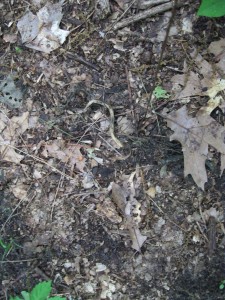Today is a good time to take a walk in the forest, but then any time is. It’s a really good time for a walk in the beech-maple forest, because a very rare orchid blooms this time of year.

In beech-maple forest, the canopy is continuous and dense except where a tree has recently been lost. Photo 29 August 2011 Pavilion Township by Richard Brewer
The orchid is three birds orchid (Triphora trianthophora). It’s known from Kalamazoo County and in fact from much of the eastern U.S., but in most places it has become rare. It is now considered threatened, endangered, or extirpated in most states. The last record in Michigan was evidently in 1981, from Berrien County.
It’s possible that three birds is gone from Kalamazoo County and Michigan. Perhaps the observations in the 20th century just caught the tail of a population dwindling toward extinction–in this region; three birds seems a little more numerous in the South. However, there are some reasons why not many people are out looking in the beech-maple forests when it’s visible, and also some reasons why, even if you’re there, three birds isn’t necessarily easy to spot.
First, almost nothing else is in flower in the mesophytic forests at this time of year, so there’s not much to look at. The many species of spring ephemerals that covered the ground in April and May are gone. A few species that flower in summer are now in fruit, and it’s pleasant to be able to see the doll’s-eyes and blue cohosh. But, in general, the beech-maple forests of late summer are dark, and the ground is obscured in many places with seedlings and saplings,

Doll's-eyes (Actaea pachypoda) in fruit in beech-maple forest. Photo Oshtemo Township 17 August 2009 by Richard Brewer
mostly sugar maple, or with thick foliage of ferns, wood nettle (Laportea), wild ginger, and a few other herbs.
Three birds is a short plant, 6 inches or thereabouts, so I imagine in the shade and under the foliage, it’s not easy to see. Nevertheless, considering how important rediscovering the species would be, if you can get to a beech-maple forest in the next few days, you ought to give it a try.
There is much yet to learn about the habitat and life history of three birds. Within its mesophytic forest home, it’s said to favor sites where there’s a build-up of leaf litter and humus. Probably this means small depressions. Leaves accumulate other places, such as between two large fallen trunks, but I’m not sure if that microhabitat would be long-lived enough to allow time for the orchid to invade. But maybe it would. From observations of the Michigan botanist Fred Case in his Orchids of the Western Great Lakes Region (Cranbrook Institute of Science, 1987), I suspect that most dispersal is through underground tuberoids that are dug up, carried off, and stored in the duff and litter by red squirrels, or perhaps chipmunks.
Late in the summer, fleshy stems sprout rapidly from the underground tuberoids. Each plant bears only a few leaves which are oval, alternate, and clasp the stem. Usually there will be a few stems in a clump. Not long after the plants appear, one or occasionally more of the buds open. Flowering is possibly triggered by a couple of chilly nights in a row. It is reported that most of the plants in a given area produce their first blooms at the same time. After a day or so, the first set of blossoms shrivel, and in a few days, a second round of flowering may occur, and perhaps a third.
The flowers (often three per plant) are recognizably orchids but small, perhaps about an inch wide and an inch tall and are mostly whitish or pinkish with a greenish bearded stripe on the lip. The fruits last for a couple of weeks before slits develop that allow the release of the spore-like seedsin the following days. Although the plants are not at their showiest when they’re in fruit, this is the probably the longest period of their above-ground life. You can see how the plant looks with fruit at this Connecticut Botanical Society site with photos by Eleanor Saulys. The same site shows some plants in flower. Many more photos of flowering plants by Jim Fowler are shown at the North Carolina site linked to earlier.
So, have a look at the photos and head for the nearest beech-maple forest. If you find three birds orchids, please tell us about it in the comments section. But don’t mention exactly where you found them. (If you do give information that might allow someone to locate them, I’ll edit your comment to remove those details.) Rare plants, especially such things as orchids, have been known to disappear from sites that become known. However, you should let the Michigan Natural Features Inventory know. They’ll be tickled that three birds is not extinct in Michigan.–as will we all.










